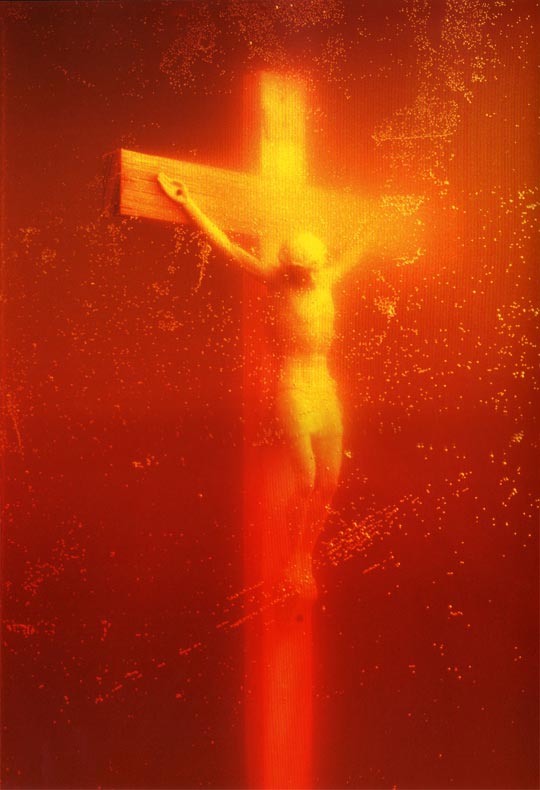
The Piss Christ scandal reminds me of the chocolate Jesus scandal, only this scandal has gone one better … or two … or three. In the case of the chocolate Jesus, the scandal was the work itself. The Catholic League fell into conniptions about a representation of Jesus which, had it been cast in bronze, would have attracted no notice, but, because it was cast in chocolate, provoked an allergic reaction. Its response was on a par with the various Islamic fundamentalists who went bonkers over Danish cartoons which portrayed the prophet Mohammed. The Piss Christ has been around long enough to attract similar responses. However, this latest scandal does not rest in the image itself, but in the act of vandalism perpetrated against the image. The vandalism can be viewed as performance art. This carries us into a second order of fundamentalist lunacy—maybe even a third order when you consider that the vandalized image is not the original but a limited edition print—maybe even a fourth order when you consider that the gallery owner has chosen to exhibit the Piss Christ in its damaged state as if it were a fresh work unto itself. It’s as if, this Eastertide, the god of art has breathed fresh life into a moribund work, and we, the slathering horde who crave meaning in our lives, have something new to cling to and overinterpret to our heart’s content.
I don’t pretend to know anything about semiotics, but clearly this is a gold mine. Religion Dispatches and HtmlGiant each offer an excellent exegesis, one sacred, the other, secular. What both articles leave unanswered is the question: Why? Why would a group of fundamentalist Christians interpret the work as a sacrilegious portrayal of the Christ when most viewers (supported by the artist’s own remarks) see a critique of sacrilegious practices and a call to resacralize what has been desecrated? After all, this is not a plastic Jesus, nor is it a plastic Jesus soaking in urine, but a photograph of a plastic Jesus soaking in urine. It is not a thing, but a commentary on a thing. Why do these fundamentalist Christian vandals not see beyond the thing to the commentary?
The clue to a possible answer lies in Milan Kundera’s remarks about kitsch as a denial of shit. Presumably his remarks can be extended from shit to piss. Fundamentalism conflates theology and an aesthetic of kitsch. Fundamentalism is an absolute denial of shit that applies with equal force to life and to art. So, for example, the only answer to death is bodily resurrection, while tragedy (in the classical and Shakespearian sense of the word) is unthinkable. Its “theology as kitsch” finds expression in bestsellers about children who have been to heaven, and it sees its visual equivalent in worship powerpoint slides that favour sunsets and the colour pink. It is a theological impossibility for saints to poop. Although fully human, Jesus could never have had sex because that would have involved a nasty emission of bodily fluids. And that kiss in the Garden of Gethsemane could never support a homoerotic reading because same-sex love is icky.
I find it astonishing that, even amongst mainstream Christians, the resurrection is a line most will not cross. They are willing to subject everything else to deep interpretation, but when Easter arrives and they confront the language of resurrection, their spiritual questing stutters to a halt. They swallow the fish, hook, line and sinker. Easter becomes a time, not of renewal or rebirth in sync with changes in the natural world, but of regression to an infantile state in which they can surrender all personal responsibility and rest in the absolute certainty that they will be cared for by some supernatural parental figure. Meanwhile bunnies cavort in the grass and chicks drop chocolate eggs in our lap.
There is a sense in which all Christianity, even in its liberal iterations, panders to the emotionally immature. Nevertheless, I believe it is possible to acknowledge the fact of death as an absolute finality without either a devolution into “theology as kitsch” on the one hand, or “theology as despair” on the other.
Perhaps that is why Serrano’s Piss Christ is so compelling. It embraces both the kitsch (the plastic Jesus) and the despair (the piss) and transforms them within a wider aesthetic (the Cibachrome photograph). Through art, it suggests a theological possibility: the affirmation of a spiritual maturity that comes from integrating rather than denying our impulses. At times, we all are afraid. At times, we all live in denial. At times, we all grow angry and smash things in acts of betrayal. Yet we all have within us the capacity to draw these impulses to ourselves, and in doing so, to become whole.
Perhaps surprisingly, then, I find in the Piss Christ an Easter Christ, pointing to the possibility of wholeness.